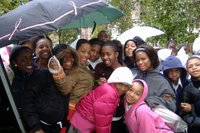 The Rosenbach is excited to partner with the Harambee Institute of Science and Technology, an African-centered charter school located in the Overbrook section of Philadelphia, for the museum’s first ever African American History in Philadelphia mapping project.
The Rosenbach is excited to partner with the Harambee Institute of Science and Technology, an African-centered charter school located in the Overbrook section of Philadelphia, for the museum’s first ever African American History in Philadelphia mapping project.
The African American History in Philadelphia mapping project is the latest in a series of neighborhood mapping projects that have linked the Rosenbach with schools throughout the city to explore the history, landmarks, architecture, and culture of the many neighborhoods of Philadelphia. Each project culminates with the publication of a “kid’s guide” that portrays communities through the eyes of the students. The map publications feature students’ drawings, photographs, research, and creative writing in response to the project. This years’ mapping project is the most ambitious yet in that it will be the first to include the entire city of Philadelphia and have a thematic focus that encompasses a 300-year time span.
The focus of the African American mapping project will be African American history, culture, and contributions in Philadelphia from colonial times to the present. Throughout the project, eighth-grade students from Harambee will be traveling to Old City, North Philadelphia, Germantown, South Philadelphia, and West Philadelphia to visit historic sites, museums, churches, parks, and other places that convey the depth and breadth of African American influence in Philadelphia. In addition, the artwork created by the students during the project will be displayed in “The Big Block!”, a city-wide exhibition at the Philadelphia Museum of Art that is being organized and sponsored by the Philadelphia Print Collaborative.
Philadelphia, in particular, offers its own unique and important African American history. It was here that the first African American church, Mother Bethel AME, was founded by Richard Allen in 1791. Philadelphia was also the site of the first-ever protest against slavery in 1688 and served as an important part of the Underground Railroad. Recent archaeological findings have uncovered the story of George Washington’s slaves who lived and worked at the Executive Mansion, owned by Robert Morris, during the 1790s when Philadelphia was the nation’s capital.
Throughout the 19th and 20th centuries, African Americans in Philadelphia continued to push for freedom and equality and became an integral part of the national civil rights movement. Philadelphia served as a home to many of America’s cultural icons, from musical legends Marian Anderson, John Coltrane and Pearl Bailey to Harlem Renaissance artists and activists Paul Robeson and Alain Locke. The African American community of Philadelphia was also the subject of a major sociological study by renowned scholar W.E.B DuBois called The Philadelphia Negro. The African American History in Philadelphia mapping project aims to explore this rich heritage and inspire further learning and inquiry.
For their first trip, the Harambee students traveled to Old City where they visited the London Coffee House, the site where enslaved Africans arrived and were sold at auction. They also visited Washington Square―known during Colonial times as Congo Square― an important meeting place for free and enslaved blacks, and Mother Bethel AME, the nation’s first African American Church. Students were treated to a performance by Keepers of the Culture storyteller Denise Valentine, who presented a story about Genora, a young enslaved woman who escapes to freedom. Despite rain and chilly temperatures, the students were excited and engaged and created amazing drawings and photographs to chronicle their experience and document these sites.
The students most recently traveled to North Philadelphia to Girard College, where in 1965 civil rights leader Cecil B. Moore staged a major protest against the school’s segregation policy. They also visited the Divine Lorraine Hotel, which was owned by legendary religious figure Father Divine; Freedom Theater, one of the nation’s longest running African American theaters; and the Johnson House, a historic house in Germantown which was a site on the Underground Railroad. Students were even able to visit the attic of the Johnson House were slaves hid until they were able to escape to freedom. We look forward to learning even more about the history and heritage of African Americans in Philadelphia as the project progresses, and we thank all of the participating students and teachers for their creativity and enthusiasm!

Law Professor Blogger Census
Dan Solove has posted the third edition of his census of blogging law profs. He reports that since his June 16, 2005 edition the number of law prof bloggers has increased 40 percent, from 130 to 182.
Find out how to buy and sell anything, like things related to georgia highway construction on interest free credit and pay back whenever you want! Exchange FREE ads on any topic, like georgia highway construction!
I think this is an extraordinary endeavor on the part of Mrs. Aisha Madhi, the gifted curator and passionate historian who spearheaded this project. Wow, the Rosenbach was majorly blessed to have such an asset on staff. Well done! African American educators and daughters of Philadelphia like myself salute you and the students of Harambee for this brilliant showcase in rememberence of a royal and promised people.
geico car insurance
best car insurance rate
best car insurance quote
car insurance policy
car insurance rating
car accident insurance
car insurance dallas
car insurance coverage
nj car insurance
collector car insurance
auto insurance company
progressive car insurance
collector car insurance
auto insurance quote
infinity car insurance
free online car insurance quote
auto insurance company
online car insurance
direct car insurance
rental car insurance
car insurance policy
low cost car insurance
car insurance canada
direct car insurance
car insurance in new jersey
affordable car insurance
california car insurance
churchil
l car insurance
allstate car insurance
antique car insurance
http://cheap-car-insurance.quickfreehost.com
Random Keyword: 🙂
budget car insurance